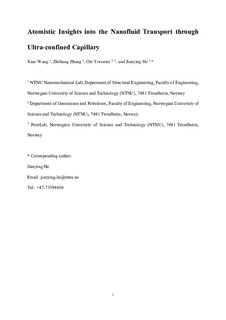| dc.contributor.author | Wang, Xiao | |
| dc.contributor.author | Zhang, Zhiliang | |
| dc.contributor.author | Torsæter, Ole | |
| dc.contributor.author | He, Jianying | |
| dc.date.accessioned | 2019-02-19T10:18:19Z | |
| dc.date.available | 2019-02-19T10:18:19Z | |
| dc.date.created | 2018-01-14T17:30:53Z | |
| dc.date.issued | 2018 | |
| dc.identifier.citation | Physical Chemistry, Chemical Physics - PCCP. 2018, 20 (7), 4831-4839. | nb_NO |
| dc.identifier.issn | 1463-9076 | |
| dc.identifier.uri | http://hdl.handle.net/11250/2586171 | |
| dc.description.abstract | The nanofluids or nanoparticles (NPs) transport in confined channel is of great importance for many biological and industrial processes. In this study, molecular dynamics simulation has been employed to investigate spontaneous two-phase displacement process in ultra-confined capillary controlled by surface wettability of NPs. The results clearly show that the presence of NPs modulates the fluid-fluid meniscus and hinders displacement process compared with NP-free case. From the perspective of motion behavior, hydrophilic NPs disperse in water phase or adsorb on the capillary, while hydrophobic and mixed-wet NPs are mainly distributed in the fluid phase. The NPs dispersed into fluids tend to increase the viscosity of fluids, while the adsorbed NPs contribute to wettability alteration of solid capillary. Via capillary number calculation, it is uncovered that the viscosity increase of fluids is responsible for hindered spontaneous displacement process by hydrophobic and mixed NPs. Wettability alteration of capillary induced by adsorbed NPs is dominating the enhanced displacement in the case of hydrophilic NPs. Our findings provide the guidance to modify the rate of capillary filling and reveal microscopic mechanism of transporting NPs into porous media, which is significant to the design of NPs for target applications. | nb_NO |
| dc.language.iso | eng | nb_NO |
| dc.publisher | Royal Society of Chemistry | nb_NO |
| dc.title | Atomistic insights into the nanofluid transport through an ultra-confined capillary | nb_NO |
| dc.title.alternative | Atomistic insights into the nanofluid transport through an ultra-confined capillary | nb_NO |
| dc.type | Journal article | nb_NO |
| dc.type | Peer reviewed | nb_NO |
| dc.description.version | acceptedVersion | nb_NO |
| dc.source.pagenumber | 4831-4839 | nb_NO |
| dc.source.volume | 20 | nb_NO |
| dc.source.journal | Physical Chemistry, Chemical Physics - PCCP | nb_NO |
| dc.source.issue | 7 | nb_NO |
| dc.identifier.doi | 10.1039/c7cp08140e | |
| dc.identifier.cristin | 1542238 | |
| dc.relation.project | Notur/NorStore: NN9391k | nb_NO |
| dc.relation.project | Notur/NorStore: NN9110k | nb_NO |
| dc.relation.project | Norges forskningsråd: 234626 | nb_NO |
| dc.description.localcode | © 2018. This is the authors' accepted and refereed manuscript to the article. The final authenticated version is available online at: http://dx.doi.org/10.1039/c7cp08140e | nb_NO |
| cristin.unitcode | 194,64,45,0 | |
| cristin.unitcode | 194,64,90,0 | |
| cristin.unitname | Institutt for konstruksjonsteknikk | |
| cristin.unitname | Institutt for geovitenskap og petroleum | |
| cristin.ispublished | true | |
| cristin.fulltext | postprint | |
| cristin.qualitycode | 2 | |
